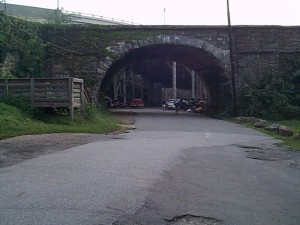When the Georgetown Branch of the B&O (or the Metropolitan Southern / Georgetown Barge, Dock, Elevator & RY Co.) was planned to run into Georgetown, DC, the final hurdle to gain access to the industrial area along Water Street was passing through the old Aqueduct Bridge which connected Washington DC to Arlington VA, or more specifically the C&O Canal to the Alexandria Canal. By linking these businesses they could mutually benefit from the port traffic. The bridge was completed some time around 1843, some 65 years prior to the arrival of the B&O tracks into Georgetown. Surely the architects of the bridge could not anticipate the RR arriving on that right of way, nor would they have wanted to, being that arrival of a RR would signify the death knell for their canal.
Nonetheless, the C&O canal was fighting a losing battle from day one. Always a great story to tell, the C&O Canal & the B&O RR began on the same day, heading in the same general direction with the same goal. They fought each other all the way, with magnificent turf battles all along the Potomac River and beyond. Of course history favored the railroad, it trumped the Canal in so many ways, the C&O Canal never really stood a chance. The Aqueduct bridge mirrors this perfectly. In its heyday, the canal bridge brought canal boats across the river in glorious fashion. But after the expense of the bridge and the decline of the canal traffic (or necessity of connecting the two areas) it was converted to a simpler truss arrangement and modified to carry wagons, pedestrians and eventually trolley cars.
After modification, the only remaining part of the bridge that hinted at its heritage as an aqueduct was the large abutment on the DC side, with its two stone arches and sunken top where the boats once traveled. These low arches provided clearance for horse and carriage to pass through to the businesses that lined the riverfront west of the bridge but not the great iron horse that would arrive on its doorstep some time around 1909-10.

In a follow up from my post from a few days ago, Mr. Bill Ulle has posted another fantastic photograph to the Old Time DC Facebook Group, documenting a moment in time that I never thought I’d actually see. In this photo, which we can assume is from some time around 1909-1910 (after the tunnel under Conduit Rd. was complete and the bridges across the C&O Canal were installed), his great uncle, Louis S. Crown is 3rd from left. This was the crew, working for the B&O that was enlarging the arch of the Aqueduct bridge. You can see all of their equipment, the stones and the newly-laid track leading up to the arch so they could move stone and timbers as they worked. To the left, you can see the crane used to move heavy equipment and stone around. Cribbing supports the arch as it is disassembled and up above you can see temporary timber and iron support for the bridge above.

The work probably took several months. In the photos it appears to be summer due to the thick foliage visible in the previous photo. These men have their work cut out for them. Here is a photo of what the arch looked like after it was completed, shown in 2004. You can see just how large the arch was enlarged to accomodate the railroad. Interestingly enough, there was a switch located right under the arch and it was numbered 24 in the later years.
Great pics! Here’s a good one from 1935, I’d be keen to find out what loco they have in the picture: https://www.pinterest.com/pin/121597258668376586/
The photo source is here: https://flic.kr/p/jCKrzC , part of the John W. Barriger III National Railroad Library collection. I’m not sure of the exact date of the image. I’m wagering the loco is a D-7, 0-6-0. Have some photos of them down there somewhere.